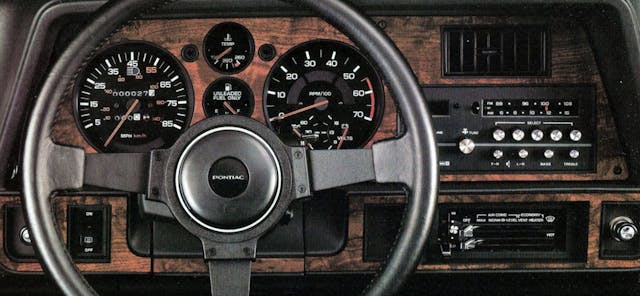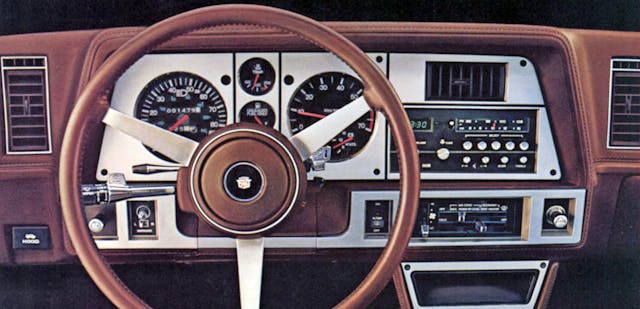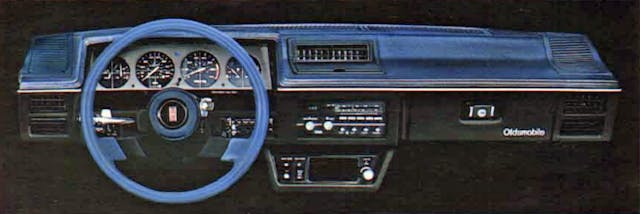Media | Articles
The Oldsmobile Firenza Performed GM’s J-Turn With A Dash Of Style
As far as driving maneuvers go, the J-turn is one of the more aggressive ways to change your direction. Ironically, a platform like General Motors’ star-crossed J-body is ideal for this action, as that front-wheel drive blueprint was born for such a dynamic maneuver. A nose-heavy vehicle swings into the “J” quicker than something with the powertrain spread more evenly across both axles. Or so I have been told by my ex-Marine classmates in one particular class back in college.
Not that we put this into practice in the back of the student parking lot with rental cars, but if we did, I’m certain it would have been better in the innovative 1982 Oldsmobile Firenza. The innovations weren’t under the hood, mind you, as the Oldsmobilian “J” had a rocky start like every other J-car possessing that crude 1.8-liter pushrod mill.
The second year of Oldsmobile Firenza production added a fuel-injected, overhead camshaft 1.8-liter engine from GM Brazil to enhance the rest of the platform’s potential goodness, but that’s not where I’m going. The innovation stared you square in the face, as the J-body Oldsmobile has an enduring legacy of advanced styling. Oh, you didn’t know?



There’s no doubt the Firenza was a uniquely trimmed J-car, with a streamlined plastic nose worthy of the Endura-equipped Pontiac GTO. While wraparound turn signals were added in 1984 to soften the blow of that aggressive cheese wedge of a face, there’s no doubt where Saturn’s iconic “face” came from.
And that legacy is why the Oldsmobile Firenza is the most forward-looking J-car, as it gave brand recognition to GM’s multi-billion dollar gambit. The Saturn division drained valuable resources from other GM brands, but swiping the Firenza’s minimalist, grill-free schnoz without giving Oldsmobile any credit was beyond shameful.
Marketplace
Buy and sell classics with confidence


Clearly GM’s Rocket-themed brand was needed to reach Saturn, but the cribbing of the Firenza playbook happened again in the mid-1990s. This time the call came from inside the house, as the flagship Oldsmobile Aurora found inspiration from the bottom drawer of the brand’s history cabinet. With Aurora, the Firenza’s aggressive wedge face became a rounded, bubbly tribute to the enduring appeal of this forgotten design on a shunned platform.
Sigh. Come on people: give the Oldsmobile Firenza the credit it rightly deserves! This car had a dash of style that masked the depressing legacy of GM’s most diminutive vehicle, and history needs to see this truth. Speaking of dashes, let’s discuss that dashboard.




Like many Holiday-trimmed Oldsmobiles before it, the Firenza was available with a full set of gauges, a sporty steering wheel, and a manual transmission. But what made the forgotten Firenza unique in a sea of GM J-bodies was something Oldsmobile never promoted to would-be customers: differentiation.
Notice how the Firenza’s dashboard lacks the deeply hooded trapezoidal shape found in the J-bodies of Chevrolet, Pontiac, and Cadillac. The irony of a Cadillac sharing a Chevy dashboard while Oldsmobile stands on its own four wheels is rather delicious.


But this is General Motors in the 1980s, and the Oldsmobile brand having the power and budget to make their own J-body control panel makes no sense. So take a look at another forgotten J-car, one made in the same factory as the Firenza. Meet the 1982 Buick Skyhawk, or its dashboard at least.
Perhaps there’s more to the story of dashboards, but all I can find is the commonality in assembly plants, and the Buick-Oldsmobile-Cadillac (BOC) management consolidation happening at this time. Clearly the most prestigious BOC department (Cadillac, with the Cimarron) needed to look different from the other two, so robbing parts from the Chevrolet Cavalier to stand out must have made sense to someone. Not to the consumer, of course, as a Cimarron with a variation of the dashboard above would surely have faired significantly better than robbing stuff from a Chevy.
But forecasts are just that, and Motorweek understood the climate in which the J-cars were released into the wild. The harsh reality of falling gas prices when the nation was bracing for another wave of spikes and shortages left the downsized, front-wheel drive American cars of the late-Malaise era flat-footed. All that hard work to advance the automobile, just for buyers to clamor for primitive Chevrolet Malibu Classics and Ford LTDs must have been a tough pill to swallow for R&D departments across the Metro Detroit area.
The Retro Review from America’s foremost automotive television program also brought up the “Jedsel,” as every industry wonk knew the first year (1982) J-cars landed in the market with a resounding thud. The aforementioned powertrain upgrades in 1983 (1.8 OHC for Oldsmobile, bigger 2.0-liter OHV for Chevrolet) ensured the rest of the J-cars’ engineering had something to work with. The Firenza S tested by Motorweek appears to have Oldsmobile’s “Firm Ride/Handling Package” to go with those comprehensive gauges in its better-than-Cadillac dashboard. The good vibes it generated prove that General Motors could produce a front-wheel drive vehicle worthy of tight, twisty roads.
It’s a shame most folks didn’t check the right boxes in the first place, especially on the forgotten Firenza. And Motorweek also noted that fit and finish on the J-car’s sophomore year was finally up to GM’s hype in promotional material. Perhaps they said it best when they said the 1983 Firenza was “a nice, good-looking car.”


But like so many things in the go-go ’80s, it was far too easy to fall behind the curve. Like an Atari 2600 and its meager 128 bytes of RAM doing battle with the Commodore 64 (which had 64 kilobytes of that stuff), the Firenza was out of its element by 1988. A new front clip was added to mesh with the similarly restyled Cutlass Ciera, but it was too late for the formerly radical J-car with a face that moved mountains on Saturn.
The assembly line that made both the Firenza and its dashboard-sharing Buick Skyhawk officially shuttered on April 15, 1988. While the Skyhawk moved to another factory, disappointing sales of the Firenza ensured this was the end of the road. The little Buick mustered 529,564 units sold, while Oldsmobile only shifted 282,460 Firenzas with only one fewer year of production. Over two million Chevrolet Cavaliers came to life at the same time, and even 152,245 units of Cadillac’s (presumably) high-profit margin Cimarron highlights the Oldsmobile’s depressing sales performance.

It’s always a shame when a design with so much promise gets swept under the rug, but it’s even worse when its face winds up on a premium compact brand that gave GM a big head in the 1990s. Insult to the injury comes when Oldsmobile itself bet the farm on a luxury car with that now iconic face in clear view.
But the forgotten snout of the 1982-87 Firenza (sorry, fans of the 1988 model!) might one day resonate with others as an underrated design. At least one can hope, because it clearly had a “dash” of unique style.


















This car is largely forgotten. Olds was never really a small car company. It was a major seller with the Supreme RWD and the 88. When they lost these cars it move the target to kill a division from Pontiac to Olds.
The move to down size and FWD killed Olds.
Pontiac was set to die but the Grand Am sales took off and saved the division.
FWD killed Oldsmobile? You mean way back in ’66, when the division brought forth the Toronado?
No when they made everything FWD and down sized in the 80’s. To be honest even in 66 it was more gimmick than anything else.
Then the Cutlass Supreme went FWD it was all failure after that.
Imagine if the Aurora was a REW or AWD car? A V8 over 300 HP via front wheels is a waste.
I had a ’97 Aurora. The HP was 250. Cadillac wouldn’t let Olds have the 300HP version.
The point is RWD would have been better.
The early Toronados had a lot of HP, and per C&D, essentially no torque-steer. This was said to be due to proper front suspension and half-shaft design. Some FWD cars have a lot more torque steer than others, even today.
Torque steer is far from the only issue with FWD.
It is difficult to put power down even with equal shafts. Handling is not as good as it could be and you lose the ability to control the car with throttle as there is terminal understeer.
They did FWD to copy Cord and to open floor space up. But RWD would have been much better on these cars.
I have driven them and while just tooling around they are ok they are not cars to be pressed.
BMW and Benz avoided FWD as much as they could for a reason.
The bottom line is if RWD remained on Olds they may have lived longer.
These were forgettable cars. The only sporty part was the gauge cluster.
They skipped the best version of them all. The 1987 Sunbird GT turbos with the 2.0. The Sunbirds went from 96hp to 165hp with the 2.0 turbo. I had a GT sedan with an auto (wife can’t drive stick), red/black outside and black guts. Loved that little car. And it was the last divisional engine built by any GM brand. Could get it in a Grand Am too. Sure it had torque steer to spare, but hold on and go. No intercooler and even with 2500 mile oil changes my turbo puked at 34,000 miles because of that. Added a post-oiler into the repair and it never happened again. Had all options except the sunroof and it went out at $13,744 MSRP. Turns out they only built 280 sedans with an auto, should have kept it. One problem on all these J bodies was that GM was experimenting with a marine sealer on the bottom of the doors. Keeps water out yes, but it also CONTAINS water which rusted the door bottoms on all of these. On the dashboard discussion in the story, the GT turbos had their own gauges within the normal Cimarron/J2000/Cavalier layout. When the GMC Syclones and Typhoons came out, they didn’t have a dash for them that would work so they put the dash from the Sunbird GT turbos in those. Look for it next time you see one. When you see one today, its usually a convertible. My Pontiac dealer didn’t even want to order a sedan with that engine and waste extra profit he could get using his turbo engine allocations on a convertible, but I got it ordered. Rarest Sunbird body with the turbo was the hatchback which if I remember right was about 115 cars.
We considered ordering a cute 1984 Sunbird convertible with the turbo-4, but the only manual available was a 4-speed – and my wife and I both wanted a stick-shift, and I felt that a 4-speed was not good enough by 1984. The story went that GM did not have a strong enough manual tranny to handle the turbo’s torque. We ended up buying a 1984 Mustang GT convertible with the 5-speed, still have it, and have never regretted it.
This article is like: “Alfred E. Neuman was a teen idol. Let me explain…”
yup. “can’t make a silk purse out of a sow’s ear.”😂
Yeah, if I’m slumming it in J-car land, I’d go Skyhawk T-type turbo here or Sunbird GT.
Like your takes, Sajeev. Always. But I got in trouble at work years ago using “iconic.” Not trouble really but I can’t forget it. I do draw the line at Saturn’s front end being “that word.”
Thank you for reading Nicolas, but I use that word because sometimes it applies to the brand. And I bet the handful of Saturn faithful will use that word to describe that face too: https://www.hagerty.com/media/people/saving-saturn-a-different-kind-of-car-collector/
I always remember the Firenza well. That was the car that was going to be my first new car in 1986! I was going to get, ahem, a good deal from my uncle who was the sales Manager at Elizabeth Oldsmobile, in Elizabeth NJ. well I looked it over excitedly and my uncle said, hey let me show you something over here that’s newer and nicer. Gm’s N car, the Calais. It was newer and nicer and I wound up getting it at $1200.00 more then the Firenza. All in all a good car that really plowed through the snow. was still runninig at my next trade in, at 168,000mi.
It’s ” not your fathers Oldsmobile”. It’s your slightly younger recently divorced aunts, who should spend less time sunbathing at the beach since moving to Florida.